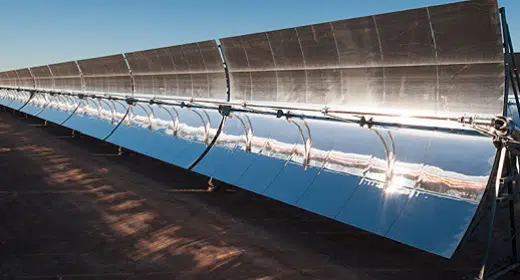by John Engel: To lean on old sports cliché, it’s not about how you start, it’s how you finish…
In the U.S., concentrated solar power’s start can be summarized as a sputter. After several starts and stops over the past 30 years, CSP’s operational capacity in the U.S. is roughly 1.8 GW. Solar photovoltaic technology, meanwhile, claims about 113.5 GW of capacity, with most of its growth occurring over the past decade, according to the Solar Energy Industries Association.
So, why is the Biden administration investing up to $30 million in CSP research and development? The Department of Energy (DOE) is offering $25 million to fund CSP research, development, and demonstration and another $5 million for novel projects.
Experts say CSP could be key to helping the U.S. reach ambitious decarbonization goals. It just needs a do-over.
Bumps in the road

Spanish CSP developer Abengoa owns more than half of the installed capacity in the world, including several of the largest plants in the U.S.
The failure of some projects, and a general lack of knowledge surrounding CSP technology, are to blame for the limited success of CSP in the U.S., according to Miguel Mendez Trigo, head of renewables and energy storage at Abengoa.
There is an urgent need for an “education campaign” to demonstrate the value CSP can offer in both power generation and thermal energy storage, he added.
CSP’s stumble off the starting line allowed lithium-ion batteries to take a commanding lead in the energy storage space, while also allowing natural gas to defend its territory.
The opportunity
CSP uses mirrors (heliostats) and receivers to collect and concentrate the full spectrum of sunlight as heat. CSP plants can be used to generate electricity. They separate themselves from competing technologies through their ability to store energy for long durations using a thermal energy storage system.
The growing need for long-duration energy storage to support renewable generation on the grid presents the greatest opportunity for CSP to soar.
CSP can provide the 12-24-hour storage capacity that the grid is already beginning to crave, said Craig Turchi, who leads the National Renewable Energy Laboratory’s CSP program. One challenge for CSP deployment is finding a market structure that rewards its unique and valuable qualities.
A CSP thermal storage system can also increase capacity more economically than battery energy storage systems, which typically cost the same for the next megawatt hour as the first, an advantage as renewables continue to scale.
“From a financial perspective, the trick is, how do you get paid for having that advantage?” Turchi said. He said that if an owner is only getting paid when when putting electricity on the grid at the same cost, “then there’s no advantage in having that thermal storage.”
The industrial sector, with its own set of decarbonization challenges, could gain the most from CSP thermal energy storage deployment. That’s particularly true if it replaces natural gas in heat-driven processes like the production of steel, cement, ammonia, and fuels, Turchi said.
DOE’s research funding for CSP is dedicated to demonstrating projects in the industrial sector and advancing research in particle-based thermal systems. Those systems could be less complex than current molten salt systems.
So, while CSP had a rough start in the U.S., DOE and the Biden administration aren’t giving up hope. Their climate goals may depend on it.





















































